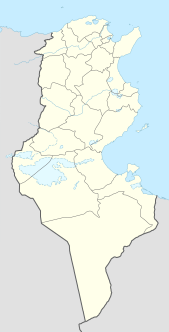
Gafsa, originally called Capsa in Latin, is the capital of Gafsa Governorate of Tunisia. It lends its Latin name to the Mesolithic Capsian culture. With a population of 105,264, Gafsa is the 9th-largest Tunisian city.

Thelepte was a city in the Roman province of Byzacena, now in western Tunisia. It is located near the border with Algeria about 5 km north from the modern town of Fériana and 30 km south-west of the provincial capital Kasserine.

Assuras, sometimes given as Assura or Assur, was a town in the Roman province of Proconsular Africa.

Sufes was a town in the late Roman province of Byzacena, which became a Christian bishopric that is included in the Catholic Church's list of titular sees.
Coela was a Roman city and bishopric in the province of Europa and is now a Latin Catholic titular see.

Vegesela in Byzacena was a Roman Era town tentatively identified with ruins at Henchir-Recba in modern Tunisia. The town was in the Roman province of Byzacena.
Ausafa or Uzappa was a Roman era town, in the Roman province of Africa Proconsularis and in late antiquity Byzacena.

Auzegera was a Roman-Berber town in the province of Africa Proconsularis and in late antiquity Byzacena. It was a Catholic Church diocese.
Bouderies is a settlement in Kasserine, Tunisia, in North Africa.
Cenculiana was a Roman era town in Roman North Africa.
Henchir-Baldia is an archaeological site and locality in southern Tunisia. The stone ruins are tentatively associated with Bladia, a civitas of the Roman province of Byzacena during the Roman Empire. It was a Catholic bishopric.

The Diocese of Aquensis in Byzacena is a home suppressed and titular see of the Roman Catholic Church.

Edistiana was an ancient Roman–Berber city in the province of Africa Proconsularis and in late antiquity of Byzacena. It was located in the modern Tunisia. It was a former Catholic diocese.

Muzuca was a Roman Town of the Roman province of Byzacena during late antiquity. The town has tentatively been identified with the ruins at Henchir-Besra in modern Tunisia. Very little is known of the city, though in situ epigraphical evidence gives us the name and that in late antiquity it achieved the status of Municipium.

Septimunicia is a titular bishopric of the Roman Catholic Church. The location is not certain, but assumed to be in Tunisia. Today Settimunicia survives as a titular bishopric and the current bishop is Emilio Bataclan, of Cebu.

Gratiana was an ancient city and bishopric in Roman Africa, which remains a latin catholic titular see.

The diocese of Tanudaia is a suppressed and titular see of the Roman Catholic Church located in today's Tunisia.
The Diocese of Sita was a Christian diocese in Africa Proconsularis. It is presently a bishopric of the Roman Catholic Church.

The Diocese of Zella is a suppressed and titular see of the Roman Catholic Church.

The diocese of Dionysiana is a suppressed and titular see of the Roman Catholic Church.





